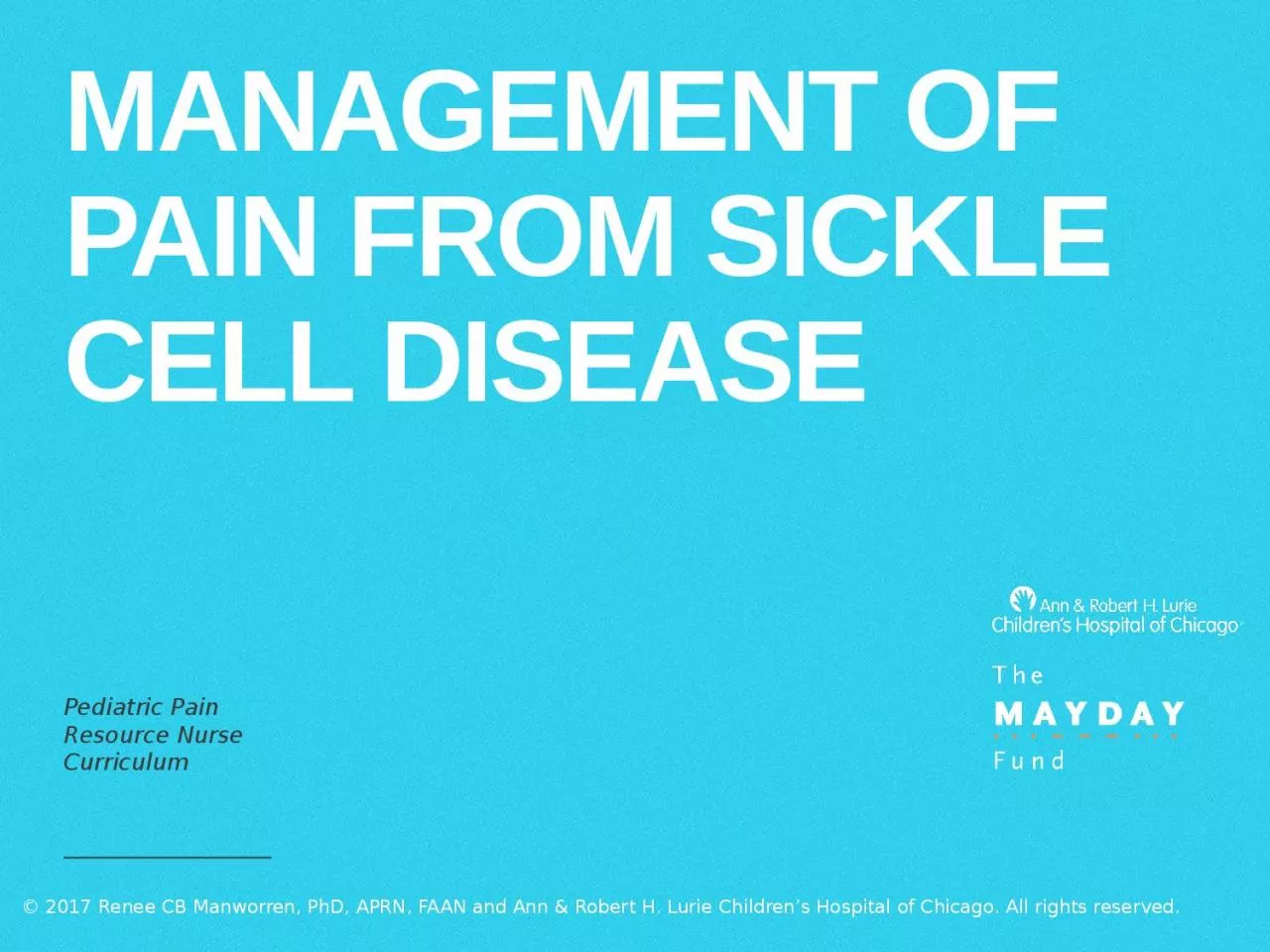

Pediatric Pain Resource Nurse Curriculum Sickle Cell Disease Prevalence In the US the disease effects 100000 people 1500 African Americans 110001400 Hispanic Americans Symptoms associated with SCD do not usually present during first 6 months ID: 934316
Download Presentation The PPT/PDF document "Management of Pain from Sickle Cell Dise..." is the property of its rightful owner. Permission is granted to download and print the materials on this web site for personal, non-commercial use only, and to display it on your personal computer provided you do not modify the materials and that you retain all copyright notices contained in the materials. By downloading content from our website, you accept the terms of this agreement.
Slide1
Management of Pain from Sickle Cell Disease
Pediatric Pain Resource Nurse Curriculum
Slide2Sickle Cell Disease:
Prevalence
In the US, the disease effects:
100,000 people1:500 African Americans 1:1,000-1,400 Hispanic Americans Symptoms associated with SCD do not usually present during first 6 monthsAcute pain is the hallmark and most frequent reason for hospitalization of children with SCDIn 1973, the average lifespan of a person with SCD in the US 14. The only available cure is hematopoietic stem cell transplant.
Sickle cell disease (SCD)
is an i
nherited, autosomal, recessive disorder
that causes red blood cells to assume a sickled shape
Slide3Sickle Cell Disease:
Pain prevalence
Pain associated with SCD is:
UnpredictableSudden Onset Recurrent Any and all locationsWorse than postoperative pain and is as intense as terminal cancer pain. Children with SCD experience:
VOCEveryday pain as other childrenPost-operative pain with increased frequency of surgical procedures
Abdominal pain from splenic sequestration
Chest pain from Acute Chest Syndrome with respiratory infections, asthma exacerbation or after surgery
A hallmark symptom of SCD is PAIN!
Slide4Vital Signs:
HR 100, BP 140/86, RR 24 T 37
Pain location:
Headache & both legs and lower back Pain Intensity: “12” on a 0-10 scalePain Quality: “Like I need to be in the hospital” ConstantAggravating factors : “Moving, walking” Alleviating factors: “nothing”
Christopher
What are your first impressions?
Which pain assessment strategies or approaches would you use?
Slide5Sickle Cell Disease Management
Supportive management
Symptomatic management
Preventative management Abortive management Curative therapy
Slide6Hydroxyurea
for prevention
of VOC and other SCD complications
Utility of hydroxyurea for all patients with Sickle Cell Anemia is clear & indisputableHydroxyurea is an antineoplastic agent and a potent inducer of fetal hemoglobin.Adult SCD patient clinical trials demonstrated effectiveness for increasing fetal hemoglobin production and decreasing total WBC without significant bone marrow suppression. BABY HUG study - Phase 3 clinical trial testing Hydroxyurea versus placebo in young children with SCD (ages 9-18 months at start of trial).
Slide7Sickle Cell Disease
Pain Management
Principles of pain management
Use developmentally appropriate pain assessment strategiesConduct a thorough pain assessmentDetermine the patient’s and family’s goals of careIncorporate multimodal therapiesPrevent or rapidly treat adverse effects
Reassess frequently and change therapies if neededEducate patients, families, other caregivers
Pain phases
Slide8Christopher says he needs 5mg of IV hydromorphone and diphenhydramine
He went to school everyday, but was too tired to do homework and just tried to rest on a heating pad.
He took ibuprofen everyday this week. Today he also took more than a dozen morphine pills that did not relieve his pain.
His prescription drug monitoring program record shows he was prescribed hydrocodone & it was dispensed 3 weeks ago . He has not been prescribed morphine in the past year.
Christopher
What next steps would you recommend?
Slide9Pharmacologic treatment
Acute VOC is
routinely treated with:
Corticosteroids and ketoprofenNSAIDS and aspirin AntihistaminesOpioids Antidepressants Alpha 2 adrenergic agonists
BenzodiazepinesKetamine
+
Anticipate opioid doses will be higher in patients with SCD who have been routinely treated with opioids. than recommended starting doses for children.
Slide10Biobehavioral treatments
Slide11Christopher
What would you expect to do for his pain?
Slide12How do your personal experiences, beliefs, and/or attitudes influence your pain assessment and care for patients with SCD?
Slide13Admit or Discharge?
Slide14Health-related quality of life (HRQOL)
VOC negatively impacts HRQOL
Decreased functioning
Increased fatigueDecreases in school performance.Emotional distress
Consider sociodemographic variables and barriers to care
Slide15Christopher
What barriers may prevent Christopher from adhering to this discharge plan?
How can you break down these barriers?
Christopher is discharge from the ED
A follow-up appointment is arranged with Hematology in 3-5 days unless symptoms worsen.
Christopher is sent home with prescriptions for an opioid and ibuprofen as needed.
Slide16Christopher
What education should be provided to Christopher and his family?
Resources that
might be of assistance:
Starlight Children’s Foundation
www.starlight.org
Sickle Cell Kids
Sicklecellkids.org
University of Michigan Medicine: Pain in Sickle Cell Disease
med.umich.edu/
yourchild
/topics/sicklecell.htm
Slide17Key Points
Pain prevalence
Pain from SCD is primarily due to somatic and visceral tissue injury from
vaso-occlusive (VOC) events. Pain associated with SCD is:unpredictable, of sudden onset, recurrent,
At any and all locations (joints, abdomen, limbs, back, headache), and more intense
than postoperative pain
Goals of pain management
Pain management is focused on efforts to prevent, eliminate, and/or reduce painful sensations.Pain management includes both pharmacological and biobehavioral methods to effectively control or alleviate pain so patients can live life with optimal quality.
Provider, patient, & societal bias threaten achievement of these goals
Acute pain is the hallmark and most frequent reason for hospitalization of children with sickle cell disease (SCD).
SCD Management
Supportive
Symptomatic
Preventative
Abortive
Curative therapy
Slide18How would you rate your ability to care for children with pain associated with SCD?
How will you address bias?
What resources do you need for your team?
What is your next step?